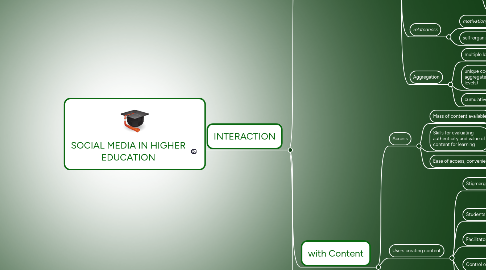
1. INTERACTION
1.1. with Other People
1.1.1. Fluid Roles
1.1.1.1. Learner role
1.1.1.1.1. peers
1.1.1.1.2. collaborative learning / work
1.1.1.1.3. social capital
1.1.1.2. Facilitator role
1.1.1.2.1. teacher, instructor
1.1.1.2.2. peer mentor
1.1.1.3. Contributor role
1.1.1.3.1. creating content
1.1.2. learner-teacher interaction
1.1.2.1. dialogue
1.1.2.2. feedback, assessment
1.1.2.2.1. experience of competence
1.1.2.3. pedagogical guidance
1.1.2.3.1. self-directed learning
1.1.3. relatedness
1.1.3.1. motivation, self-determination
1.1.3.2. self-organizing principles
1.1.4. Aggregation
1.1.4.1. multiple levels
1.1.4.2. unique cognitive function residing in aggregates (not possible at lower levels)
1.1.4.3. cumulative, collective knowledge
1.2. with Content
1.2.1. Access
1.2.1.1. Mass of content available
1.2.1.2. Skills for evaluating authenticity and value of content for learning
1.2.1.3. Ease of access, convenience
1.2.2. Users creating content
1.2.2.1. Stigmergic, i.e. 'signs left in the environment'
1.2.2.1.1. Digital artefacts documenting/ demonstrating learning, i.e. e-portfolios
1.2.2.2. Students co-creating learning content
1.2.2.2.1. Self-directed learning
1.2.2.2.2. Collaborative work/learning
1.2.2.3. Facilitators presenting content in new ways
1.2.2.4. Control of online presence
1.2.2.4.1. Privacy
1.2.2.4.2. Heterogeneous identity
1.2.2.5. Distribution
1.2.2.5.1. lack of control over how content you created is used
1.2.2.5.2. Influences user's affilitation with aggregates, may be unknown to user
1.2.3. Links between content
1.2.3.1. Pathways of learning for users, machines
1.2.3.1.1. STIGMERGIC
1.2.3.2. Collective knowledge
1.2.4. Informal learning content
1.2.4.1. Personal Learning Network
1.2.4.1.1. self-directed learning
1.2.4.2. Administrative information
1.3. with Tools
1.3.1. User Interface
1.3.1.1. Design
1.3.1.1.1. Does it parallel natural (social) processes?
1.3.1.2. Orchestration "hardness/softness"
1.3.2. Matched to Task
1.3.2.1. Pedagogical purpose, relevance
1.3.2.1.1. To what degree does the tool (combined with pedagogy) transform learning?
1.3.2.2. Acceptance
1.3.2.2.1. Motivation
1.3.2.3. Does it facilitate self-organizing?
1.3.3. User Preferences, Perceptions
1.3.4. Guidance on Use
1.3.4.1. Technical skills
1.3.4.1.1. Job skills development
1.3.4.2. Pedagogical relevance
